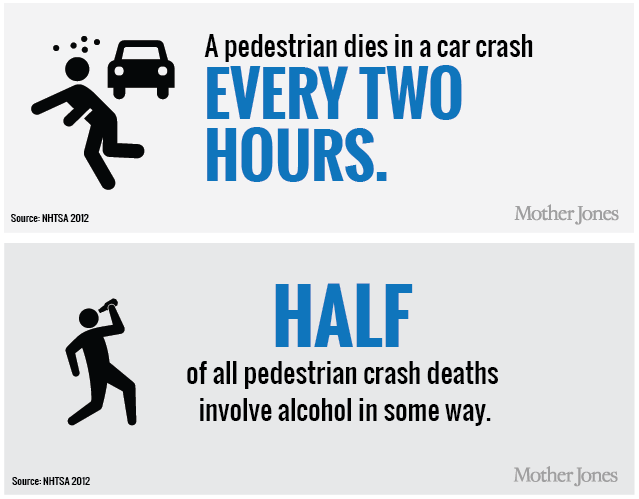
This was the New Year's revelry advice from Mother Jones, the left-wing, reader-supported magazine: Whatever you do, don't walk anywhere after drinking. That's because, Maddie Oatman writes, it makes you more likely to be struck by a driver.
As the basis for her reporting, Oatman used some well worn stats from the National Highway Traffic Safety Administration. In a recent report, NHTSA noted that about a third of pedestrians killed while walking had blood alcohol content of .08 percent or higher at the time. That spurred a victim-blamey, click-baity frenzy in the national media about the dangers of "drunk walking" -- as if people on two feet have the same responsibility to remain sober as people operating heavy machinery.
It's extra disappointing to see a progressive publication like Mother Jones fall into this trap. Telling people not to walk drunk because they might get struck by a car is like telling college women not to drink because they might get raped. It takes a structurally vulnerable class of people -- pedestrians -- and puts the onus on them to prevent violence at the hands of another group. It is victim blaming, plain and simple.
Walking, on its own, is plainly not dangerous, and neither is walking drunk. What adds an element of risk is traffic -- fast-moving traffic in particular. Entirely overlooked in the the NHTSA study and Mother Jones was how road design puts pedestrians -- whether they're healthy and alert and fit, or affected in some way by old age or disability or alcohol -- in harm's way.
Most pedestrian fatalities take place on a single type of road: urban arterials. These are the wide, high-speed streets that funnel traffic through cities. Most of these roads are designed with little to no thought for the needs of people on foot.
When people are violently killed while walking on these streets, blame is frequently placed at the feet of the victims. When children are struck by drunk drivers because they didn't walk a third of a mile to the closest crosswalk, the pedestrians get blamed. When people have the audacity to walk at night without special light-colored or reflective clothing, pedestrians get blamed. That has a lot to do with the relative powerlessness of people who rely on walking for transportation, as author and activist Ben Ross laid out beautifully in a recent article in Dissent Magazine.
Meanwhile, countries that have achieved major declines in pedestrian fatalities are not blaming the victims. They're solving the problem by reining in drivers in urban areas. Sweden, the country with the "safest roads ... in the world," according to the Economist, has reduced road fatalities by 80 percent over the last few decades by building roads "with safety prioritized over speed or convenience."
Unfortunately, in the United States, for our safety institutions and even our progressive media, the "paradigm shift" hasn't quite sunk in. We're still pointing the finger at the most harmless and marginalized class of people on our streets.





